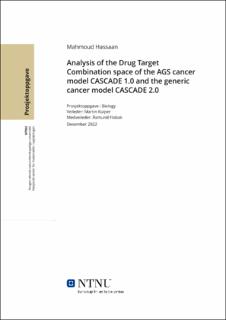Analysis of the Drug Target Combination space of the AGS cancer model CASCADE 1.0 and the generic cancer model CASCADE 2.0
| dc.contributor.advisor | Kuiper, Martin | |
| dc.contributor.author | Hassaan, Mahmoud | |
| dc.date.accessioned | 2023-02-17T18:19:29Z | |
| dc.date.available | 2023-02-17T18:19:29Z | |
| dc.date.issued | 2022 | |
| dc.identifier | no.ntnu:inspera:118880061:64770714 | |
| dc.identifier.uri | https://hdl.handle.net/11250/3052138 | |
| dc.description.abstract | ||
| dc.description.abstract | Logical models are a promising method to predict the drug combinations without testing the massive number of possible combinations experimentally. In this project we analyzed two logical models the AGS cancer model CASCADE 1.0 and the generic cancer model CASCADE 2.0 to confirm the previously discovered targets in addition to discovering a new targets that can be used as future cancer treatment target. Using different methods like the synergy scores, determinative power data and COLOMOTO notebook to find the high frequency nodes among the synergy combinations and identify the druggable and non-druggable nodes. The effective model is the model that predict all the possible combinations without missing any true positive combination. By comparing the resulted nodes from each method, we can find the most common nodes that have high score in most of them this will give us a few numbers of possible combination that can be tested experimentally rather than testing all the possible combinations. | |
| dc.language | eng | |
| dc.publisher | NTNU | |
| dc.title | Analysis of the Drug Target Combination space of the AGS cancer model CASCADE 1.0 and the generic cancer model CASCADE 2.0 | |
| dc.type | Master thesis |
Tilhørende fil(er)
Denne innførselen finnes i følgende samling(er)
-
Institutt for biologi [2615]
